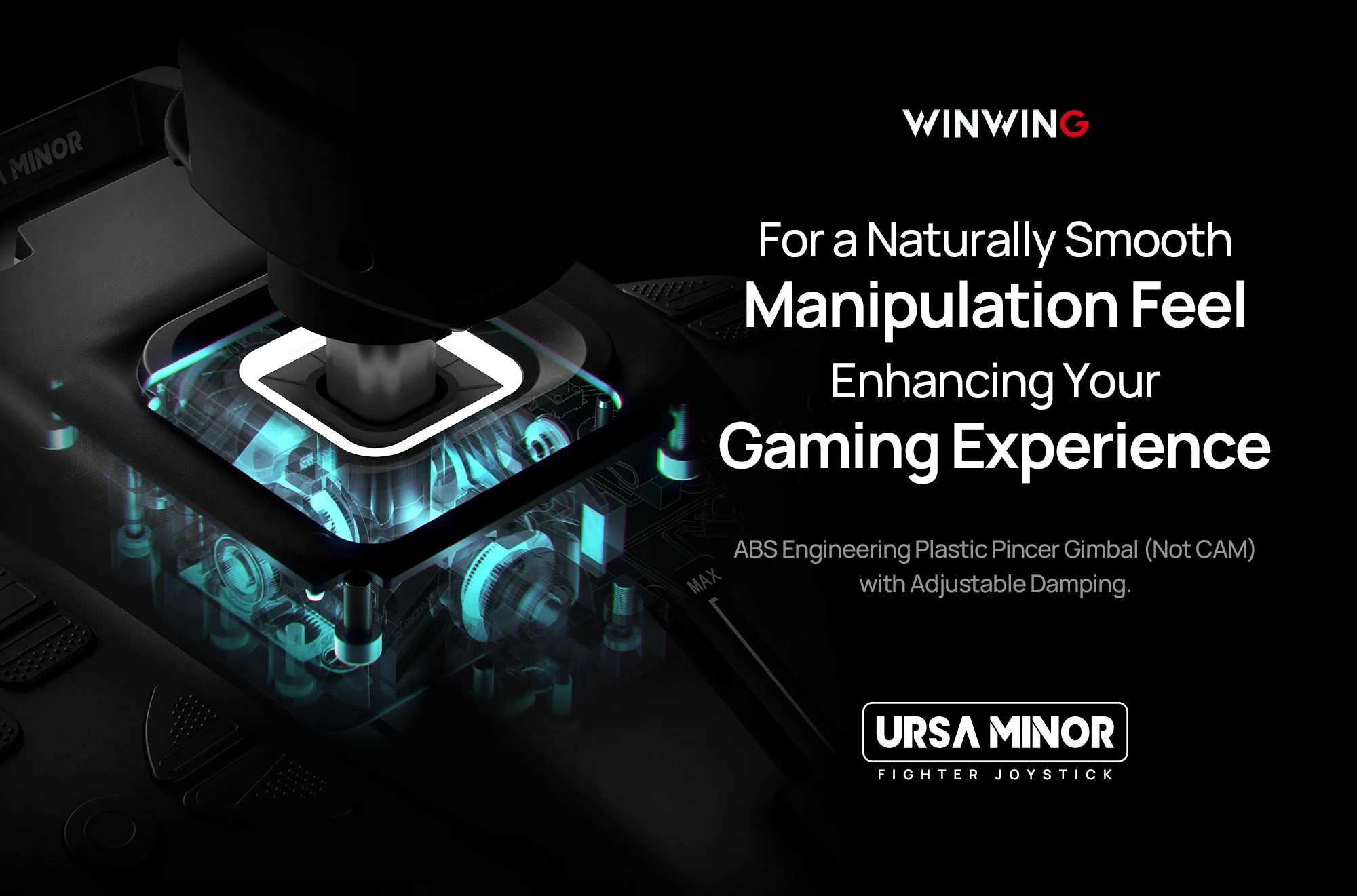Explore enhanced gaming experiences with WINWING’s Ursa Minor joystick – the brand’s debut into the realm of budget-friendly peripherals. Crafted to offer precision control and immersive gameplay without the hefty price tag, the Ursa Minor presents a practical option for gamers of all levels. Whether you’re a casual player or a seasoned enthusiast, this joystick brings affordability and performance together seamlessly, promising a refreshing approach to gaming peripherals.
You can NOT purchase the product at this point in time, and you can NOT see any information about this product on the website.
There is no official release trailer yet.
Note: This product was provided as part of the closed-beta test group, and you can read about my previous announcement here.
Full Disclosure
The WINWING Ursa Minor were sent to me for free by WINWING, however, this review is my own and is not influenced by WINWING to review in a favourable way.
Price
Note: I will post what was leaked and then I will post what was announced on a few hours ago. (this way you can see what was assumed at the time of writing this article – but not published, and the updates made after publishing)
Link to announced pricing here.
It was assumed it could cost approximately $110 USD based on these images with a listed price of ¥799.00 Yuan
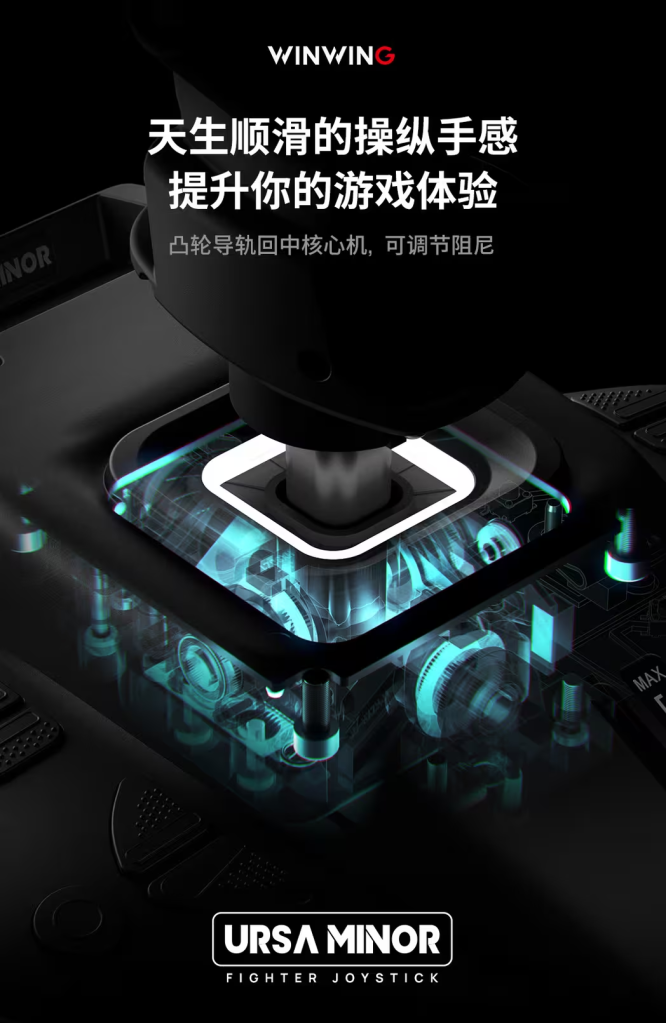

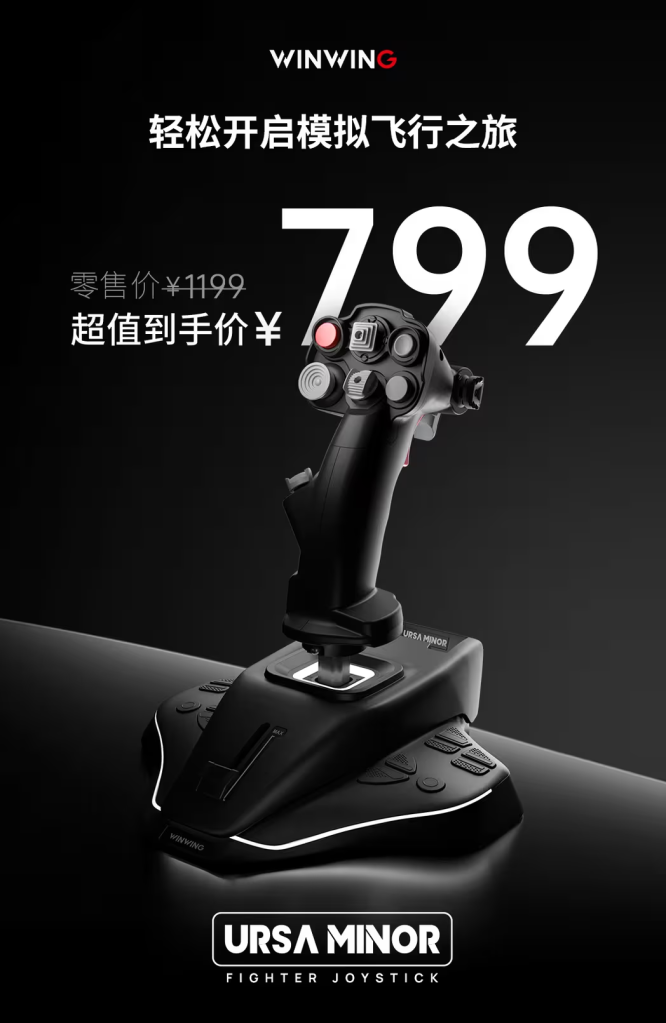

Now for the official announcement images.
You will notice that my assumptions were very close based on the leaked information.
What’s in the box:
Note: This product is a closed-beta product and the items provided in the box may differ from the production unit.
★ Joystick & Base (pre-installed)
★ Axis lockout plates
★ Allen Keys, and additional Screws
Rating Update
I’ve faced criticism regarding my rating system, with some finding it confusing. From my perspective, it makes sense as I construct the review and ratings based on my subjective experience with the product while objectively comparing similar features in its category.
In an effort to enhance transparency, I’ll provide detailed explanations for each section (Unboxing, The Look, The Feel, The Software, My Configurations). It’s important to note that these are my personal rating recommendations. If you have questions, feel free to reach out. However, snarky and unhelpful comments are counterproductive. Instead of making baseless assumptions, it would be more constructive to seek assistance. Let’s engage in a more mature and meaningful conversation. Thank you.
I assign either a half or a full star to each element in my rating, and the total rating for each category will not exceed 5 stars. If an element fully meets my expectations, it receives a full star. If it falls short but still performs adequately, it is awarded half a star. If an element fails to meet my expectations entirely, no star will be awarded.
Unboxing
Note: The closed-beta test product didn’t come with any production level packaging, therefore the review of the unboxing will not be rated.
Efficient Delivery Time: Unrated
Secure Packaging: Unrated
Environment-Friendly Packaging: Unrated
Accurate Order: Unrated
Customer Support and Communication: Unrated
The package was dispatched via WINWING on 12 April from China and arrived on 22 April in Australia.
The products were sufficiently bubble wrapped and placed in a cardboard box with sufficient air-pocket packaging, no damage to the products were identified.
The Dimensions
Note: no official dimensions have been provided.
I took a ruler and measured by hand and eye, the dimensions will be rough and could be wrong.
Base width ~190mm
Base length ~220mm
Base height ~60mm (without the stick)
Base height ~240mm (with stick)
The Look
Visual Design: ⭐
Build Quality: 0.5/1 ⭐ (Note: marked down for wobbly hats)
Finish: ⭐
Innovative Features: 0.5/1 ⭐ (Note: marked down for copying VKB NXT Evo gimbal)
Replica Design: ⭐
Visual Design:
The joystick’s appearance is both practical and appealing, designed with a focus on comfort and usability. It features a thoughtfully arranged layout of buttons, both on the base and the stick itself, ensuring easy access during gameplay. Its sleek, low-profile design fits seamlessly on any desktop, while the predominantly black colour scheme with subtle lighting accents adds a touch of style without being overly flashy.
Build Quality:
Overall, the joystick’s build quality is commendable. Judging solely by its appearance, this stick and base combination seems to exhibit high quality. The tight tolerances in the grip segments, the presence of large low-profile anti-slip rubber pads for stability control, dust protection fins for the slider axis, and the inclusion of additional screws to secure the switch caps all contribute to this impression of quality craftsmanship.
Finish:
The joystick’s finish is smooth and visually pleasing, featuring a matte black texture that adds to its overall appeal. The buttons on the base are textured, aiding in tactile recognition. Notably, the grip’s switch hats predominantly display grey, with the missile release and primary dual-stage trigger in red. Additionally, the slider features a finely textured grip, enhancing control and comfort during use.
Innovative Features:
Noteworthy among the joystick’s features is its innovative gimbal access mechanism, similar to a battery compartment on an RC car. However, it’s important to highlight that the gimbal design itself is a direct replication of the VKB NXT EVO, with only slight variations in material composition. The inclusion of an interchangeable grip system akin to the VKB NXT EVO could offer cross-compatibility with grips from other manufacturers, akin to established conventions in the flight simulation peripheral industry (however this functionality is not compatible at this time without DIY).
This presents opportunities similar to how the Thrustmaster Warthog and Hornet grips can be used on a VKB Gunfighter gimbal, expanding on the options for users seeking customisation and compatibility.
While the LED accents contribute to its aesthetic appeal, they are monochromatic rather than RGB.
Note: The question was raised on reddit about what a pincer design is and if it is same or similar to Thrustmaster Warthog.
Pincer-style gimbals have a lineage dating back to the CH Products/FLCS era, predating the advent of VKB and VIRPIL. While not a novel concept, the pincer design offers advantages over traditional ball-in-socket mechanisms. In the case of the WINWING joystick, its pincer-style gimbal is an example replica of the VKB NXT EVO format, sharing similar dimensions and features.
To delve deeper into the pincer design, imagine a dual-arm configuration resembling crab claws surrounding a central pivot point. This setup enables rotational movement with a spring situated in the middle. Unlike single-spring designs that manage resistive forces for both axes simultaneously, the pincer approach allows for independent management of resistive forces for each axis. Consequently, users experience more consistent tactile feedback throughout the joystick’s range of motion, mitigating the uneven spring forces common in single-spring setups.
Moreover, the pincer design facilitates easier customisation of resistive forces for each axis. By enabling straightforward spring swaps, users can fine-tune the joystick to their preferences with greater precision compared to single-spring designs.
In contrast, Thrustmaster’s gimbal design, with the exception of their newer AVA model, utilises a ball-in-socket mechanism. While this design served its purpose for over two decades, manufacturers have acknowledged its limitations and sought updates to improve user experience, drawing insights from advancements made by other vendors.
It does come with its own flaws, however. With a pincer design, there’s a center bumper that creates a stronger centering detent, resulting in a physical bump when crossing over either the X or Y axis.
Replica Design
While not directly emulating any particular model, the Ursa Minor joystick incorporates design elements reminiscent of both Russian tank-style pistol grips and jet-style aircraft controls, drawing inspiration from iconic models such as the SU-35 and SU-57. This amalgamation pays homage to established designs while offering WINWING’s unique interpretation. Notably, this approach aligns with industry trends observed in the offerings of competitors like VIRPIL and VKB, reflecting a coordinated effort to cater to diverse user preferences within the flight simulation community.


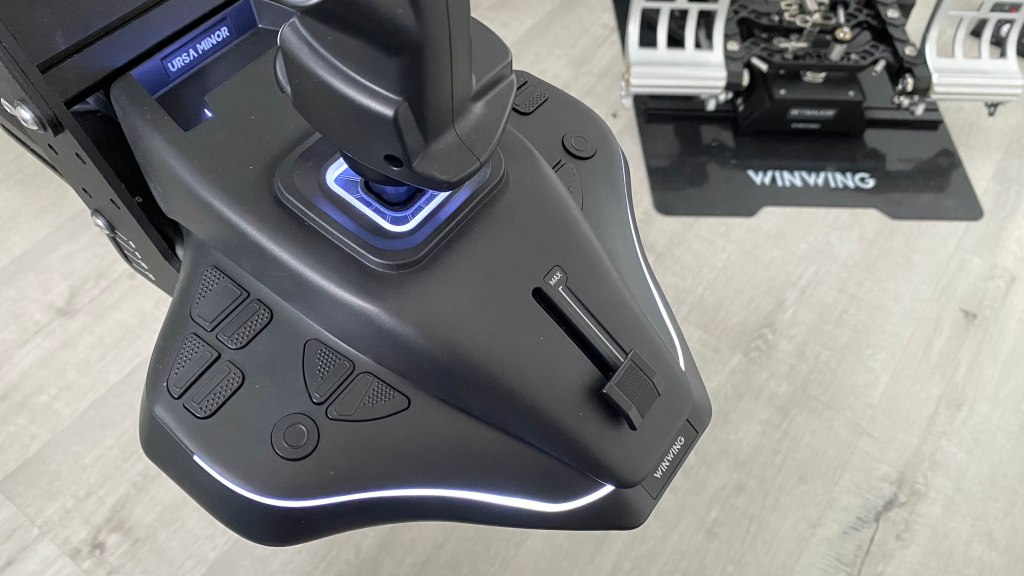


The Feel
Joystick Responsiveness: 0.5/1 ⭐ (Note: marked down due to pronounced centre bump and wobbly / loose hats)
Comfort and Ergonomics: ⭐
Durability: ⭐
Adjustability: ⭐
Realism and Immersion: ⭐
Joystick Responsiveness:
The Ursa appears to be using Hall effect sensors, offering accurate readings superior to Rotary potentiometers due to their lack of direct physical mechanical contact.
While the sensors themselves won’t be a cause for concern, the wobbly hat switches compromise the quality feel and accuracy when using them, affecting the overall feel and tightness of control inputs.
The pronounced physical center bump in the gimbal’s center, inherited from the flawed design of the VKB NXT, significantly impacts the joystick’s responsiveness. This flaw, particularly evident in helicopter simulation, where delicate maneuvers such as “stirring the pot” are essential, can pose considerable challenges for users aiming for realistic flight experiences.
Comfort and Ergonomics:
The joystick provides a comfortable and ergonomic grip, with the exception of accessibility to base buttons on the same side as the hand in use, requiring the user to momentarily release their grip. However, this inconvenience is mitigated by the buttons’ suitability for ancillary controls rather than primary combat functions.
Durability:
The joystick feels sturdy and durable, exhibiting minimal flex when squeezed, unlike other low cost joysticks, which tends to exhibit flex and creaking under pressure. This difference is likely attributed to the thicker plastic and reinforced design employed in the Ursa’s construction.
Additionally, some rattling is present in the base buttons, noticeable when the joystick is shaken, due to the installation of the base buttons without rubber rings. However, this is well within expectations and tolerances during practical use. Overall, these design choices contribute to a robust and long-lasting gaming peripheral with minimal risk of wear and tear.
Adjustability:
The joystick offers good adjustability, with accessible spring adjustment for customisable tension. However, it’s worth noting that no additional springs were provided, likely due to this being a closed-beta tested product. It’s possible that additional spring choices may be offered for the production release. I will inform WINWING of this to ensure they are aware.
Additionally, if you have the Z-extension stem version, the throttle will become more apparent. The inclusion of X-axis lockout plates allows for a versatile configuration, effectively transforming the joystick into a throttle-like format when desired.
The gimbal provides two screw access points for adjusting the Y-axis damper, and one screw access for the X-axis. It’s important to note that due to this configuration, the X-axis damper will not be as strong as the Y-axis.
Realism and Immersion:
Drawing inspiration from the Russian Tank-style grip and Su-35 and Su-37 Jets, the joystick’s ergonomic button placement enhances immersion, creating a unique blend reminiscent of these iconic designs. It’s as if the two style grips had a baby, and the baby was the Ursa Minor. This amalgamation pays homage to established designs while offering WINWING’s unique interpretation.
Additionally, the inclusion of vibration feedback enhances immersion, particularly in games like DCS. However, broader compatibility with other games and simulation platforms would expand the utility of this feature, potentially enhancing the experience across various titles.
The Software
Updated Ratings: The Software
Ease of Installation: ⭐
User Interface: 0.5/1⭐ (Note: marked down due to lack of description and visual formatting)
Customisation Options: ⭐
Stability and Performance: ⭐
Update and Support: 0.5/1 ⭐ (Note: marked down due to lack of update information prior to applying firmware and poor risk mitigation of damaging devices with more than three plugged in)
Ease of Installation:
The software installation process was straightforward, requiring minimal effort.
User Interface:
Navigating through the stick testing and firmware sections of the user interface was intuitive. However, some icons and text could benefit from refinement. For instance, green qualified tests are displayed on the test screen but lack proper formatting, and certain button options, such as “Switch to S1” or “F1,” are unclear. The key binding section is also confusing, and improvements could enhance user understanding and usability. Additionally, distinguishing between different controllers (left and right) directly from the main SimAppPro device selection screen before clicking on them would be beneficial.

Customisation Options:
The software offers a variety of customisation options, including the ability to switch between analogue and digital hat modes or to combine them, as well as selecting the LED brightness level or choosing the breathing mode. These options provide users with flexibility in tailoring the physical and visual experience to their preferences.
Stability and Performance:
SimAppPro is stable, with no reported crashes during use. The program performs well, with smooth and responsive operation and no noticeable delays or stutters during selections.
Update and Support:
Updating the software and firmware is a straightforward process, facilitated by clear prompts within the program. However, providing more detailed information about the purpose of the firmware updates would be beneficial for users, allowing them to make informed decisions about applying updates.

One important observation is that when more than three devices are plugged in, a warning prompts you to unplug them before initiating a firmware update. However, upon clicking ‘Ok,’ the process proceeds without further confirmation, assuming user comfort with this arrangement. In situations where there is a risk of damaging a device, the ‘Ok’ button should not be easily accessible. Instead, it should require users to select an override checkbox, ensuring that the action is intentional and mitigating the risk of accidental damage.


My Configurations
Updated Ratings: My Configurations
not rated.
Physical Placement:
I opted to attach the joysticks to VKB UCMs (Universal Controller Mounts), making use of their universal compatibility. However, I had to customise them by drilling holes into the bottom plate to accommodate the screw pattern of the Ursa’s. Both mounts were set to their absolute minimum in height to minimise protrusion from the desk, with a 0-degree pitch and pushed as far back as possible to ensure adequate clearance for finger activation.
Physical Tune/Tweak:
On my left stick (S1 in the software), I have the pre-installed Z-extension stem version, while the right stick (F1 in the software) features the regular stem version. Both sticks retain full X and Z-axis movement to ensure full 6 DOF (Degrees of Freedom) capability in both hands.
Virtual Tune/Tweak:
Deadzones on both sticks were set to 1% to accommodate the added friction I prefer for a dampened stick feeling. Additionally, I configured the LED backlight brightness to increase when the slider axis moves to its maximum. The ministick on both sticks is configured for both axis and virtual button input, providing flexibility in usage. Vibration motors are set to default for now, as DCS is the only game supporting them.
My Comfort:
The joysticks, positioned at a comfortable height thanks to the VKB UCMs, offer a natural hand position when the desk is adjusted to forearm level. The springs are appropriately weighted, and the dampening ensures smooth operation without inducing Pilot Induced Oscillation (PIO). While accessing all buttons on the grip feels natural, reaching the same-side hand base buttons requires briefly removing the hand from the grip. However, this is not a design flaw but rather offers additional buttons for ancillary control.
Overall Experience:
My testing experience with the joysticks has been excellent. The visual appeal, with its accented lighting, is particularly pleasing, while the build quality and finish are top-notch. The grip offers great comfort, with easy access to all buttons. However, as mentioned, the wobbly hats and the center cross-over detent pose a minor inconvenience and can be frustrating. It’s worth noting that addressing these issues likely wouldn’t have incurred significant additional costs.
Regarding the software, while installation was straightforward, there is room for improvement in terms of visual aesthetics and descriptive text regarding firmware updates. Specifically, some icons and text could benefit from a refresh, and more detailed information regarding firmware updates, along with protective measures before actioning, would enhance the user experience.
It’s important to recognise that this was a closed-beta test, and all feedback has been provided to WINWING for their consideration. Ultimately, the decision to address these issues rests with them.
My Opinions
Positives:
- The joystick design is visually appealing with accented lighting.
- The gimbal offers innovative features such as interchangeable grips, spring options and clutch dampening.
- The joysticks feel sturdy and durable, with minimal flex when squeezed.
- SimAppPro software is stable, with no crashes reported during use, is easy to update software and firmware and has plenty of customisation features.
- The physical configuration options provide comfortable usage on the desk.
- The joystick utilises Russian tank & jet R&D ergonomics to enhance immersion through ergonomic button placement.
- The joystick includes features such as vibration feedback.
Negatives:
- The hat switches feel wobbly and not as tight as expected.
- The center cross-over detent in the gimbal affects fine control and precision.
- The software’s user interface could benefit from visual updates and clearer text descriptions.
- The key binding section in the software is confusing.
- The dynamic motor section in the software could benefit from an overhaul.
- The software lacks clarity regarding firmware update information.
- The software warns users to unplug devices before firmware updates but allows easy override, potentially risking damage without adequate warnings or protective measures.
Recommendations:
Negative: The hat switches feel wobbly and not as tight as expected.
Recommendation: Consider alternative hat switch designs or materials to enhance stability and tactile feedback, ensuring a more satisfying user experience.
Negative: The center cross-over detent in the gimbal affects fine control and precision.
Recommendation: Address the center detent issue in the gimbal design to improve fine control and precision during use.
Negative: Additional springs for modifying resistive forces were not provided.
Recommendation: Include a wider range of spring options to accommodate different user preferences and playing styles, enhancing customisation and adaptability.
Negative: The user interface could benefit from visual updates and clearer text descriptions.
Recommendation: Invest in updating the user interface to improve navigation and usability, while also providing clearer text descriptions for functions and features.
Controversy
The controversy surrounding the product arises from WINWING’s direct replication of the VKB gimbal design, notably the VKB NXT gimbal, which itself draws inspiration from CH Products and FLCS designs. This replication includes inheriting significant design flaws, particularly the hard center detent, which significantly impacts user experience, especially in scenarios requiring precise control, such as flying helicopters or aircraft that demand fine motor movements around the center of the gimbal.
Additionally, while WINWING’s grips are heavily influenced by designs from VKB SCG, MCG, and VIRPIL MT-50, they also integrate elements from real aircraft designs, resulting in a blend of inspiration rather than entirely original creations.
The debate transcends gaming peripherals, shedding light on broader issues of design inspiration and intellectual property. While enthusiasts and industry insiders may voice concerns, it’s crucial to recognize that such disputes often originate from online forums rather than genuine legal infringements.
Speculation abounds regarding potential backlash from VKB and VIRPIL enthusiasts concerning WINWING’s design choices. However, legal action would likely hinge on copyright and patent laws, with WINWING potentially operating within their rights if no such protections exist for the designs in question. This controversy isn’t unique to the gaming industry; many consumer products draw inspiration from existing designs without facing legal repercussions.
Overall, while the controversy may ignite debates among enthusiasts and industry insiders, WINWING’s decision to emulate existing designs reflects a common practice in the competitive landscape of consumer electronics. In an industry where innovation often builds upon existing ideas, it’s essential to balance creativity with respect for intellectual property rights.
After all, how often do we hear of toaster companies suing each other over design similarities? This tongue-in-cheek observation underscores the broader context in which these controversies unfold and highlights the need for a nuanced understanding of intellectual property in the modern market.
Thank you
Gallery

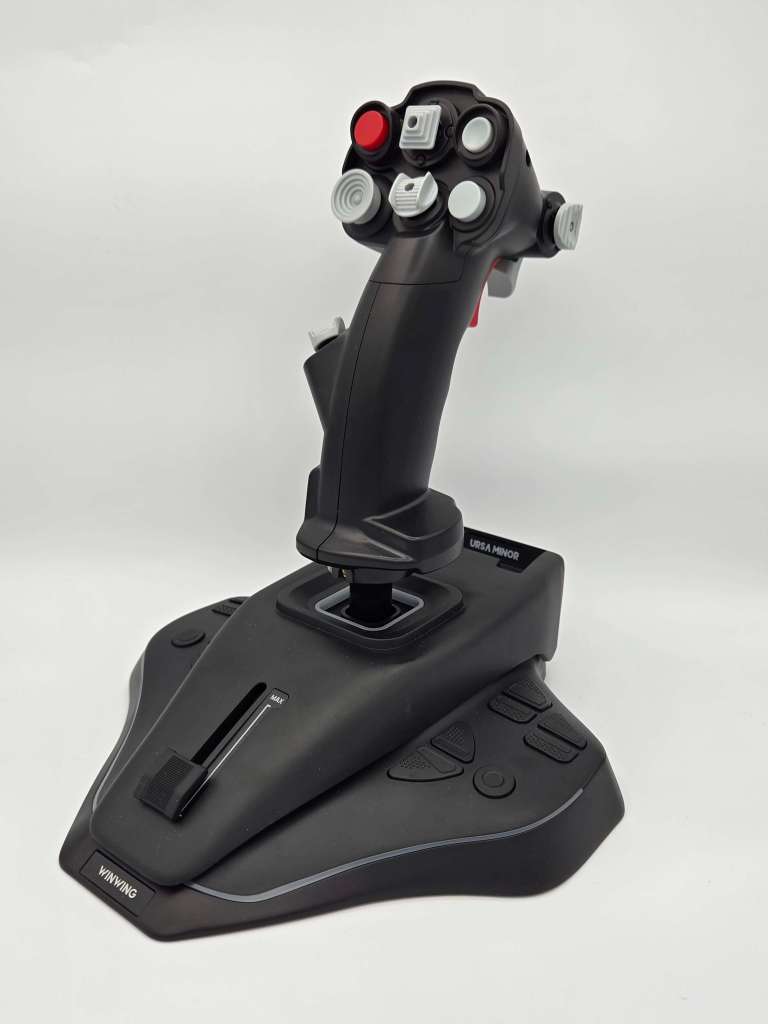

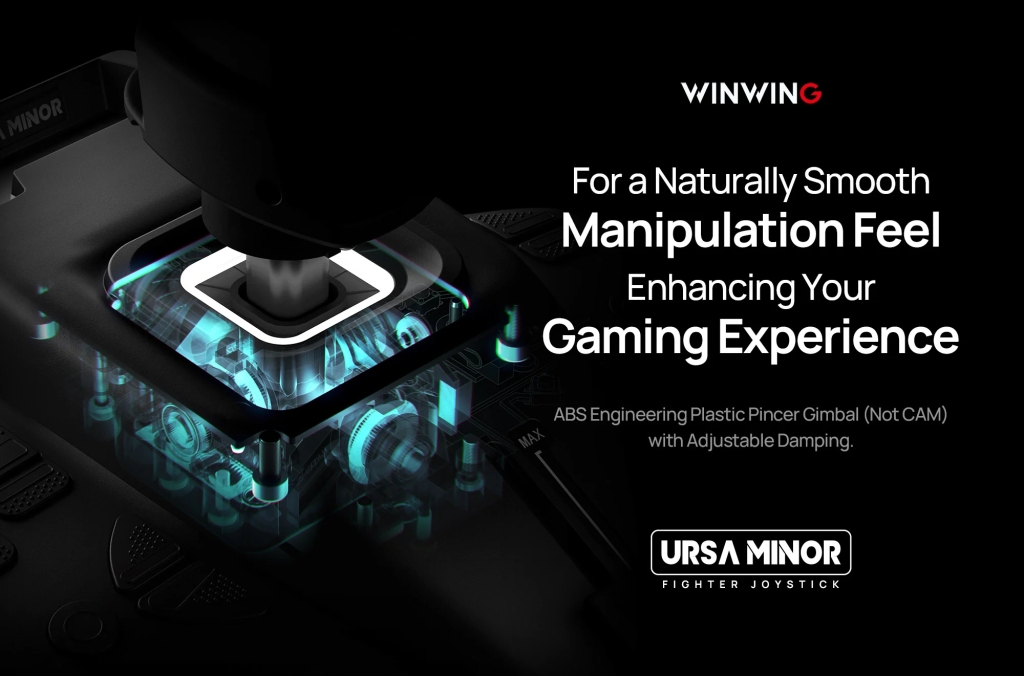


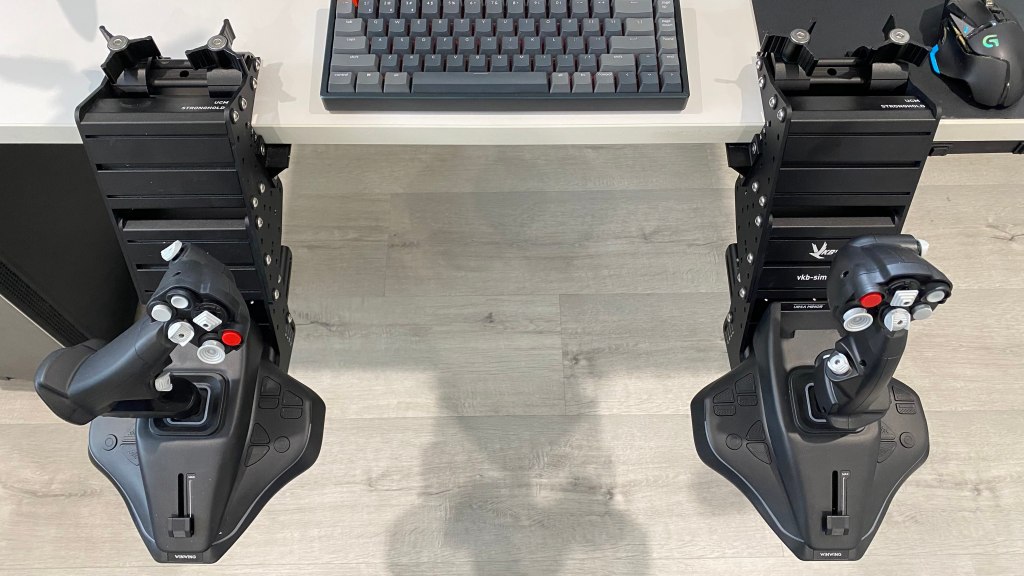
Authored by ddrake1984 on 15/05/2024


